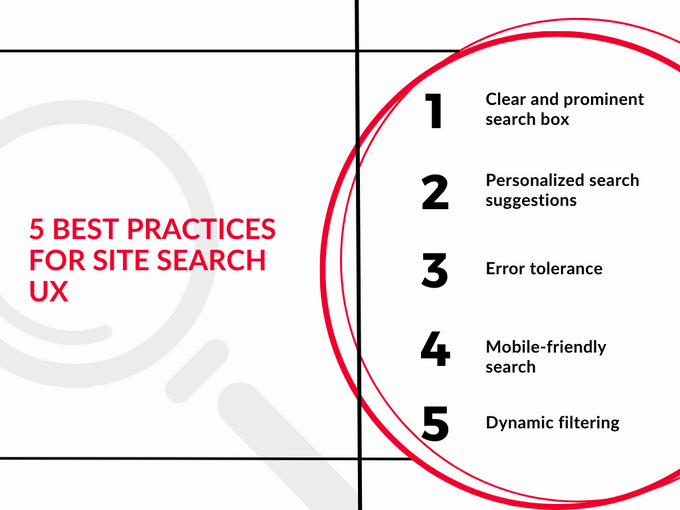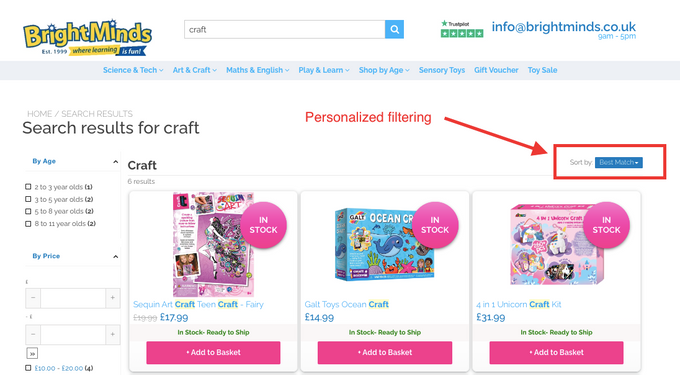5 Best Practices for Site Search UX
Don't settle for a mediocre search experience. Make your site search UX exceptional with these best practices.
Updated November 19, 2024

Nearly 45% of online retail visitors go straight to the search bar. And when they have a great search experience, they're more likely to buy.
That's a big opportunity for your business to improve your eCommerce site search experience. By improving the user experience on your site search, you can increase your chance of conversions and sales. Let's take a look at how best to do that.
Meet the Expert
Jameela Ghann is an e-commerce and marketing expert with over 10 years of experience. Apart from running her own successful online store, Alora Boutique, she's the marketing manager of Fera.ai.
» Learn how you can optimize your site search with Fast Simon.
Why is Site Search UX Important?
Almost 80% of customers don't see a brand in the same light after a poor on-site search experience. And more than half of those shoppers will leave and buy the product they're looking for elsewhere.
Good search UX keeps your customers engaged and reduces the chances of them bouncing away. After all, these customers are already motivated and ready to buy. A smooth search experience can push them towards completion.
» Keen to know more about product search? Check out the key features of an eCommerce product search engine.
5 Best Practices for Site Search UX
1. Clear and Prominent Search Box
Your search box should be easy to find and use. That's typically at the top of the page or within the main navigation bar. It should also be of a suitable size to attract attention, neither too small to be missed nor dominating the entire layout.
You can gauge the success of a clear, prominent search box by an uptick in users using the search function and a drop in bounce rates.
2. Personalized Search Suggestions
People love personalization. Why? Because when things are tailored to your interests, they're inherently more relevant and enjoyable. Personalized search benefits you and the customer you're trying to serve.
You can measure this factor’s success by a rise in click-through rates on search suggestions. Also, look for a boost in the average order value from users interacting with personalized suggestions.
You can tailor the search experience to shopping history, demographics, and personal preference, like online educational toy store Bright Minds, which sees a 25% conversion rate on personalized searches.
This feature requires machine learning expertise and access to user data for personalization. However, it can be made easier with a third-party app.
» Learn more about how personalized recommendations work.
3. Error Tolerance
Nothing is more frustrating than typing in a search query and getting irrelevant results due to typos or misspelled words. That's where error tolerance comes in. Error tolerance is your search engine's ability to understand and accommodate user errors in their search queries.
This feature requires natural language processing capabilities, error-handling algorithms, and computational resources for processing natural language.
To improve error tolerance, consider implementing AI and machine learning technology. Autofill, for example, can suggest correct terms as the user types, reducing the chance of errors. Predictive AI, on the other hand, can anticipate what the user intends to type, offering corrections even before the user finishes typing.
4. Mobile-Friendly Search
In the age of m-commerce, most traffic comes through mobile devices, so you need to optimize search for mobile.
Make sure you're fully versed on best practices for mobile compatibility in an eCommerce setting. Test responsiveness on different devices and screens. And aim for lightning-fast mobile loading speeds, especially for search results pages.
We measure success by the increase in mobile users using search and the decrease in those exiting after their search.
These days, it's also increasingly important to optimize your site search for voice queries, which come largely from mobile.
» Why voice search? Discover everything you need to know about voice commerce.
5. Dynamic Filtering
Dynamic filtering automatically adjusts the available filter options based on the user's search query and selections. Unlike static filters that remain the same regardless of the search, dynamic filters offer a more personalized and efficient experience. So your customers can refine their search based on preferences like:
- Color: Users can filter products based on their preferred color.
- Size: Users can choose to see products that are available in their size.
- Price Range: Users can set a price range to view products within their budget.
This feature makes finding the right product easier and faster. It keeps customers on your site longer and reduces abandonment rates.
Creating filters manually can be time-consuming and costly, particularly if you need a developer. Thankfully, third-party integrations can help with autogenerating filters for your eCommerce site.
» Make sure your filters are the best: Here's how to optimize eCommerce filters and avoid common mistakes
Find Your Products Fast On-Site Search
Your site’s search UX is key to a top-notch online shopping experience. After all, customers need to find products before they can buy them. Thankfully, a good site search tool.
Make sure you're focusing on your customers' experience to convert sales. You can do that seamlessly by integrating with tools like Fast-Simon's Smart Collections. We'll streamline your online search and discovery, making things easier for you and your shoppers.







